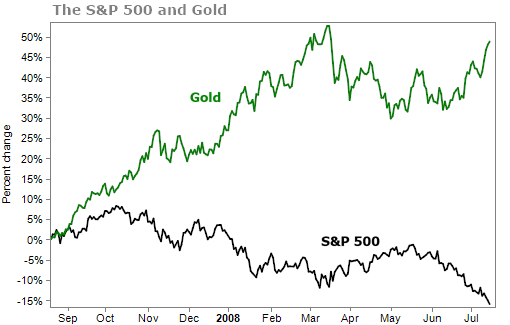You could be 25 years old and just starting out in your investing career... or 10 years into retirement... and we'd have the same advice for you.
Own some gold.
Every investor needs to own this precious metal.
The reasons are simple...
Gold is a physical asset and has been a store of value for thousands of years. Gold coins were minted for commerce beginning around 550 B.C. No matter what happens to the economy – even if banks collapse and our economic structure spirals into oblivion – gold will always have value.
Plus, the supply of gold is limited. You can't just create more gold any time you feel like it. And even in today's era of money-printing, central banks still keep huge gold reserves. Having gold in the bank makes for a credible currency.
This makes gold the ultimate "chaos hedge." When things get rocky in the economy or stock market, folks turn to gold as a safe haven. It has historically held its value across borders, cultures, and political systems... in peacetime and in war.
For example, when the 2000s housing bubble burst, stocks began to crater. But gold rose nearly 50%. Take a look...

While you should always own some gold, there are certain times you should buy more. Today is one of those times.
The knock against owning gold is that it's not a productive asset. It doesn't pay any yield like a stock's dividend. Your money just sits there, and that turns many folks away from it.
Despite that, the price of gold has skyrocketed nearly 39% over the past year (and 26% in 2025 alone). That's largely thanks to huge spikes of fear in the stock market and global economic uncertainty.
With such a big move higher, you might be thinking you've already missed your chance...
But according to my friend and colleague Dan Ferris, President Donald Trump's policies could send gold soaring from here.
Now, Dan isn't recommending gold bullion or a gold exchange-traded fund. Instead, he has found a way to supercharge any gains gold makes – allowing you to turn every $1 increase in gold's price into $4.
It's all part of protecting against an impending monetary reset known as the "Mar-a-Lago Accord," which could wipe out 40% of your savings, investments, and purchasing power in the next two years.
Now, let's get into this week's Q&A... As always, keep sending your comments, questions, and topic suggestions to [email protected]. My team and I read every e-mail.
Q: Can you explain if the organic label means anything? Is it worth paying that extra for fruits and vegetables? – O.B.
A: It depends on what you're buying...
Every year, the research organization Environmental Working Group ("EWG") creates a "Dirty Dozen" list of 12 types of produce with the highest amounts of pesticides. EWG analyzes fruits and veggies throughout the year to find which 12 products are notoriously laced with chemicals likely harmful to humans.
The most recent Dirty Dozen are (starting with the most harmful): strawberries, spinach, kale and collard and mustard greens, grapes, peaches, pears, nectarines, apples, bell and hot peppers, cherries, blueberries, and green beans. I recommend buying organic for the Dirty Dozen.
EWG also publishes a "Clean Fifteen" list of foods that rarely have pesticide contamination. They are (starting with the cleanest): avocados, sweet corn, pineapples, onions, papayas, frozen sweet peas, asparagus, honeydew melon, kiwi, cabbage, mushrooms, mangos, sweet potatoes, watermelon, and carrots. So you can save some money and buy the nonorganic versions of these fruits and vegetables.
It's also important to note that "organic" farms still use various chemicals and pesticides. They just use ones certified by the National Organic Standards Board. Two of the most common organic pesticides are rotenone and pyrethrin. At high exposure levels, rotenone has a possible link to Parkinson's disease, and pyrethrin can cause people to have tremors, aggressive behavior, and excessive salivation.
That's why you should always wash your produce. I recommend a rinse made from three parts water to one part vinegar. I let everything soak in that mixture for a few minutes and then rinse the fruits and vegetables off with just water.
Even a simple run under the tap helps a lot... A study published in the Journal of Food Protection cleaned samples of different fruits and vegetables using veggie-wash soap, electrolyzed oxidizing water, ozone, and chlorine bleach, and compared the results with simply running the food under cold tap water for 15 seconds.
Researchers concluded that while irregularly shaped foods like broccoli benefit most from being soaked rather than rinsed, the tap water was just as effective at removing E. coli and salmonella as the other treatments for smooth foods like tomatoes. And rinsing always reduced the concentrations of those harmful contaminants. That's good for folks who don't like the taste of vinegar in their salad
What We're Reading...
- Did you miss it? A day of reckoning will come.
- Something different: Can extinct animals really be brought back to life?
Here's to our health, wealth, and a great retirement,
Dr. David Eifrig and the Health & Wealth Bulletin Research Team
April 17, 2025
